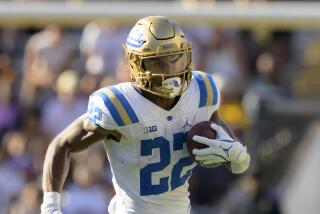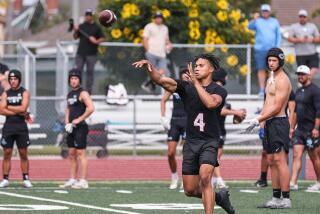A Hearty Import Takes the Field : Orange County is now home to seven teams, and the growth of the sport in recent years has been steady.
- Share via
The Super Bowl is history, and baseball season is nearly two months away.
For many fans, this time of year is a sports wasteland, but not all athletes are on the sideline. Some are in the middle of their season.
The rugby season.
Orange County is home to seven rugby teams, and the growth of the sport in recent years has been steady, if not spectacular.
The Unicorns were founded in 1970 in Los Angeles, moved to Huntington Beach a few years later and now practice and play their home games at Mile Square Regional Park in Fountain Valley.
Other teams based in the county are the Back Bay Club of Newport Beach, Finlander RFC (rugby football club) of Anaheim, the Tustin-El Toro Tough Guys, the Orange County Bucks (who are based in Fullerton), and the Cal State Fullerton and UC Irvine teams.
Although the two local universities’ teams are on the “club,” rather than varsity level, meaning they receive no financial support from the school, the players are students.
Rugby has long been popular in the Ivy League and other East Coast schools, according to Scott Ogden, past president of the Unicorns. And, he says, it’s making some headway in the West.
“It has become an intercollegiate varsity sport at UC Berkeley,” Ogden said, “and, while it’s still a club sport at Cal State Long Beach, it’s very popular there, and their team made the collegiate national finals last year.”
From Santa Barbara County to San Diego County, there are probably 50 active teams, according to Bob Goss, a player and assistant coach for the Unicorns. The most competitive are in the Southern California Rugby Football Union.
Teams are grouped into three divisions, depending upon their finish from the previous year. That is, the best teams are in the first division, next best in the second division, and the least experienced clubs and those with the poorest records from the previous season are in the third.
The system is a carry-over from the way teams are organized in Great Britain, where rugby evolved from soccer nearly 150 years ago.
The story of its evolution may be apocryphal, but the sport’s history has it that a student in the English town of Rugby couldn’t get the hang of kicking a soccer ball, so he picked it up and ran with it. The game developed from there, and American and Canadian football evolved around the start of the 20th Century, in large part from rugby.
In Southern California, earlier teams were dominated by players relocated from England, Scotland, Wales and Ireland. Today, according to Goss, most of the players are American-born, with transplanted New Zealanders second in number.
“Most of the people on these clubs saw it being played here and got interested,” Goss said.
Locally, practice begins in October, preseason games start in November, and the annual Finlander tournament, late in December, matches Orange County teams and those from nearby communities.
The Unicorns won December’s tournament, defeating the Back Bay Club in the title game.
The tournament was begun 17 years ago as a fund-raiser, according to Finlander president Tom Brand, and has developed into an attraction that now draws 12 teams each winter. “It’s a great way to get the season started,” Brand said.
League games are held from January to March, and playoffs begin shortly thereafter. Last year’s national champion came from Southern California when Old Mission Beach, a San Diego club, defeated a team from Washington, D.C., in mid-May.
In addition to the 50 Southern California men’s teams, there are another 10 women’s teams and several “old boys” or “masters” teams for players over 35 or, in some cases, 40. Ogden, the Unicorns’ past president and himself an “old boys” player, said most of the first division clubs have seniors teams.
At a time when professional athletes--particularly baseball players--are signing multimillion-dollar contracts, rugby players, who are amateurs, not only are not paid but must pay their own dues each year to cover costs of uniforms, equipment, referees and insurance.
There is no admission charge for the games, but even if there were, it wouldn’t bring in much revenue. Ogden said Unicorns’ games against Belmont Shore, traditionally a major rivalry, attract only about 100 people, “and that’s a pretty good crowd for us.” Still, all games are open to the public, and some teams have acquired players from among those who became interested after seeing the sport played for the first time.
The college teams, Cal State Fullerton and UC Irvine, play most of their games against other university opponents. Cal State Fullerton was to have been on campus last Saturday against UC San Diego, while UC Irvine was scheduled at home against Cal Poly Pomona. Both games were canceled because of wet fields.
“They call the games when it rains because they don’t want to damage the field,” Ogden said of the cancellations, “not because the players are afraid of injury. We like the rain. It helps wash off the dirt.”
Rugby players seem to enjoy their macho image.
Many tell tales of a player’s ear being sewn back on after a collision or of a broken nose (there are no helmets or padding in the sport) being stuffed with cotton. In most such accounts, the player goes back into the game and often scores the winning goal. In truth, the injuries are usually fairly minor.
“Sure, there are some injuries,” said Goss, assistant coach of the Unicorns. Most, however, he said, are in the nature of facial cuts, shoulder separations and knee sprains. He believes more serious injuries are kept to a minimum, unlike American football with its list of broken legs and blown-out knees, because rugby permits no blocking, and only the player with the ball may be tackled.
Despite the sport’s growth, it still operates in comparative anonymity. An official at Mile Square Park, asked last week if the rains would result in the cancellation of games, said “Rugby? What’s that? I don’t think we have that here.”
At Cal State Fullerton, the athletics department referred a call to the recreation office, where a student--apparently not knowing the school fielded a team--tried to send the caller back to the athletics department. A caller to directory assistance asking for the telephone number of the Southern California Rugby Football Union instead was given the number of a Tustin law firm.
While rugby doesn’t enjoy the worldwide popularity of soccer, its devotees say it is far more interesting to watch and certainly has much more scoring.
“It’s a fast-moving game,” said Goss. “It’s exciting. More exciting than American football, if played well, and more people have a chance to be in on the action,” unlike American football, in which only quarterbacks, running backs and pass receivers generally handle the ball.
“The rules in rugby are identical worldwide,” he said. “You know wherever you’re playing what the situation will be.” The game is played on a field--called a pitch--110 yards long from goal to goal, from 65 to 75 yards wide with an end zone 25 yards deep. Those dimensions are identical to those of Canadian football.
The ball resembles an American football but is slightly more rounded, allowing it to be drop-kicked in a field goal try, once a prominent play in football in this country.
The pitch should be 75 yards wide, Goss said, and must be at least 65 yards in width, if a 75-yard field is not available. As games are often held on high school fields, rugby players sometimes must play wherever they can.
The object of the game, which consists of two 40-minute halves with no timeouts, is to score a “try,” the equivalent of a touchdown. In fact, the ball must be touched down in the end zone for the try, which is worth 4 points. The player must cross the goal line and place the ball on the ground. After the try, a conversion is kicked through goal posts similar to those in football.
What isn’t similar to football is that there is no forward pass, there are 15 men on the field for each team, and there is virtually no substitution.
While the local teams look to the programs at Cal State Fullerton and UC Irvine for future personnel, most also are willing to take a look at other would-be players. The Finlander team, which practices at Yorba Regional Park in Yorba Linda at 7 p.m. Tuesdays and Thursdays, welcomes those interested in playing to attend its practices.
More to Read
Go beyond the scoreboard
Get the latest on L.A.'s teams in the daily Sports Report newsletter.
You may occasionally receive promotional content from the Los Angeles Times.










